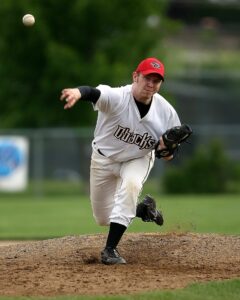For many players, early trunk rotation or over rotation can reduce pitching velocity. A common misconception is that “striding straight” will help reduce the risk of early trunk rotation. However, is this true? Our research suggests this piece of advice might not be accurate.
Is Pitching Velocity Affected by Stride Direction into Foot Strike?
You may have heard many different pieces of advice on stride. For instance, “stride straight at the plate,” “don’t stride across your body,” or “don’t open your stride.” All of these directions refer to how the front foot lands after foot strike. Many coaches believe that striding straight at the plate helps a pitcher get their shoulders square with home.

Conventional wisdom says that having an open stride might cause the pitcher to open their shoulder too early. By contrast, a closed stride could cause incomplete trunk rotation and cause the player to throw across their body. Coaches who adhere to this philosophy believe that pitching velocity and the pitcher’s arm health may suffer if the player doesn’t stride straight at the plate.
To test this theory, we looked at a group of players to determine their landing positions and also their trunk rotation with motion analysis. We tested players of different skill levels from high school players to professional athletes. The results were that about half of the players had a straight stride. Around one-third had a closed stride, while about 12% had an open stride.
Surprisingly, the group that was most likely to over rotate were actually those in the straight stride group. However, this difference was slight. We didn’t find any significant differences in trunk rotation angle between the groups.
Based on years of research, our team believes that the stride direction into foot strike is more a matter of pelvis and hip rotation than trunk rotation. This may come down to the player’s signature, not biomechanical efficiency.
Other Things to Work On for Trunk Rotation Inefficiencies
So, what should players work on if they have rotation inefficiencies? Generally, giving the “stride straight” advice will only work for about half of players. The other half may have a hard time finding consistency and efficiency in their pitches with this advice. It may also affect their pitch speed because it may interfere with their personal signature.
Instead, our coaches may focus on many different things to help players get their shoulders square to the home plate. For example, we might help them tweak their set up, the angle of their leg lift, or move them on the rubber till their spine is centered at release. The great thing is that we can personalize pitching instruction to the player.
Help Improve Pitching Velocity, Accuracy, and Mechanical Efficiency with Our Program
At National Pitching, we are dedicated to helping pitchers improve their skills with an all-inclusive science-backed program. We don’t just teach a lesson, we give you a tool kit to help you boost your performance. We help players of all ages and skill levels, from youth pitching players to MLB stars. Our professionally trained coaches teach all elements of the Tom house program for Pitcher’s Health and Performance Matrix and provide individualized instruction for each player. Find a pitching coach near you today or sign up for exclusive access to our large video library of online pitching instruction!
